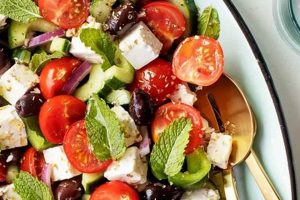Combining the freshness of leafy greens and other salad components with the sweet and slightly tart flavor of cherries creates a unique culinary experience. Imagine vibrant red cherries nestled amongst crisp lettuce, creamy goat cheese, and crunchy pecans, drizzled with a light vinaigrette. This exemplifies the delightful contrast in textures and tastes that cherry-centric salads offer.
Such dishes provide not only a delicious but also a nutritionally beneficial meal option. Cherries are rich in antioxidants and vitamins, adding nutritional value to the already healthy components of a salad. Historically, fruit and savory combinations have appeared in various cuisines, and the incorporation of cherries into salads reflects this enduring culinary tradition, offering a refreshing twist on classic preparations.
The following explores various approaches to incorporating this versatile fruit into salads, examining different cherry varieties, complementary ingredients, and dressing options to create a range of appealing and healthful dishes.
Tips for Crafting Cherry Salads
Creating a balanced and flavorful cherry salad involves careful consideration of ingredients and techniques. The following tips offer guidance on maximizing the flavor and visual appeal of these unique dishes.
Tip 1: Cherry Selection: Opt for fresh, ripe cherries. Sweet varieties like Bing and Rainier pair well with milder greens and cheeses, while tart cherries, such as Montmorency, complement bolder flavors like blue cheese and walnuts.
Tip 2: Pitting Efficiency: Utilize a cherry pitter for quick and efficient removal of pits without crushing the fruit. Alternatively, a small paring knife or even a sturdy straw can be employed.
Tip 3: Balancing Flavors: Consider the sweetness of the cherries when selecting other ingredients. Balance sweetness with contrasting flavors like tangy cheeses, peppery greens, or acidic dressings.
Tip 4: Textural Variety: Incorporate a variety of textures to create a more engaging salad. Nuts, seeds, croutons, and crumbled cheese offer contrasting textures to the softness of the cherries and greens.
Tip 5: Dressing Choices: Light vinaigrettes, particularly those with a touch of sweetness or acidity, complement cherry salads well. Balsamic, honey-mustard, and poppy seed dressings are excellent choices.
Tip 6: Ingredient Incorporation: Add the cherries just before serving to prevent them from bleeding their color onto other salad components and to maintain their fresh texture.
Tip 7: Presentation Matters: Arrange the salad components thoughtfully for an appealing presentation. Consider the colors and shapes of the ingredients to create a visually engaging dish.
By following these tips, one can elevate a simple salad into a sophisticated and satisfying culinary creation, highlighting the unique and versatile nature of cherries.
These insights provide a foundation for experimenting with different cherry salad combinations, empowering culinary exploration and enjoyment.
1. Fresh, Ripe Cherries
Fresh, ripe cherries are essential for crafting exceptional cherry salads. Their quality directly impacts the overall flavor, texture, and visual appeal of the dish. Using cherries at their peak ripeness ensures optimal sweetness and juiciness, creating a delightful contrast with other salad components. Conversely, using underripe or overripe cherries can result in a bland or overly tart flavor, detracting from the intended balance. Consider a salad featuring fresh mozzarella, basil, and ripe Bing cherries the sweetness of the cherries complements the creamy mozzarella and peppery basil, creating a harmonious flavor profile. If the cherries were underripe, the salad would lack the necessary sweetness, while overripe cherries might introduce an undesirable mushiness. This demonstrates the importance of cherry selection in achieving the desired result.
The ripeness of cherries also affects their texture within the salad. Ripe cherries offer a satisfying firmness that holds up well when combined with other ingredients. They provide a pleasant burst of juice when bitten into, enhancing the sensory experience. Overripe cherries, however, tend to be softer and may break down or bleed their color onto other components, compromising both the visual appeal and textural integrity of the salad. This is particularly noticeable in salads with lighter-colored ingredients, where the cherry juice can create an unappetizing stain. For instance, a spinach salad with feta and cherries would suffer visually if the cherries were overripe and stained the delicate spinach leaves.
Selecting fresh, ripe cherries is crucial for achieving the desired flavor, texture, and visual appeal in cherry salads. This understanding allows for informed ingredient selection, leading to more successful and satisfying culinary outcomes. The practical application of this knowledge ensures that the final dish not only tastes delicious but also presents beautifully, enhancing the overall dining experience. Careful attention to cherry selection underscores a commitment to quality and flavor, elevating a simple salad into a culinary masterpiece.
2. Complementary Ingredients
The success of a cherry salad hinges on the careful selection of complementary ingredients that enhance and balance the cherries’ sweetness and slight tartness. These ingredients contribute not only to the overall flavor profile but also to the texture, visual appeal, and nutritional value of the dish. Understanding the interplay of flavors and textures is crucial for creating a harmonious and satisfying salad experience.
- Cheeses
Various cheeses provide a creamy counterpoint to the juicy cherries. Soft cheeses like goat cheese, feta, and burrata offer a tangy complexity, while harder cheeses such as parmesan or aged cheddar contribute a sharper, nutty flavor. The choice of cheese significantly influences the overall taste profile of the salad, creating opportunities for both subtle and bold flavor combinations. For instance, a salad with goat cheese, cherries, and candied pecans offers a balanced sweet and tangy profile.
- Nuts and Seeds
Nuts and seeds add a satisfying crunch and boost nutritional value. Almonds, walnuts, pecans, and pumpkin seeds provide healthy fats, protein, and textural contrast. Toasted nuts enhance their inherent flavors, adding depth to the salad. Consider a salad with spinach, cherries, toasted almonds, and a balsamic vinaigrette the almonds provide a satisfying crunch against the softer ingredients.
- Greens
The choice of greens forms the base of the salad, impacting both flavor and texture. Mild greens like spinach, butter lettuce, or romaine provide a neutral backdrop, allowing the cherry and other ingredient flavors to shine. Peppery greens like arugula or watercress offer a more assertive flavor that complements the sweetness of cherries. Arugula’s peppery bite contrasts beautifully with sweet cherries and creamy goat cheese.
- Other Fruits and Vegetables
Incorporating other fruits and vegetables expands the flavor and nutritional profile. Sliced cucumbers, red onion, avocado, or berries create a more complex and visually appealing salad. The addition of blueberries or strawberries complements the cherries while adding another layer of flavor and color. A salad with cherries, blueberries, feta, and a poppy seed dressing demonstrates this multifaceted approach.
The interplay of these complementary ingredients elevates cherry salads from simple to sophisticated. The careful balance of flavors, textures, and colors transforms a basic combination of ingredients into a cohesive and satisfying culinary creation. The choice of each element contributes to the overall experience, demonstrating the importance of thoughtful ingredient selection in crafting a truly exceptional cherry salad.
3. Balanced Flavor Profiles
Balanced flavor profiles are essential to successful cherry salads. The inherent sweetness of cherries necessitates the incorporation of contrasting flavors to prevent the salad from becoming cloying. This balance is achieved through strategic ingredient selection, considering the interplay of sweet, tart, savory, and bitter elements. A salad featuring solely sweet cherries and mild greens would lack complexity. However, introducing a tart element like goat cheese or a bitter component such as arugula creates a more nuanced and satisfying flavor experience. The goal is to create a harmonious blend where each flavor complements the others without any single taste dominating.
Consider a cherry salad with goat cheese, candied pecans, and a balsamic vinaigrette. The sweetness of the cherries and candied pecans is balanced by the tangy goat cheese and the tartness of the balsamic vinaigrette. This interplay of flavors creates a dynamic profile that engages the palate. Similarly, a salad with cherries, spinach, blue cheese, and walnuts offers a different flavor experience. The sweetness of the cherries contrasts with the pungent blue cheese and the earthy walnuts, while the spinach provides a neutral backdrop. These examples illustrate how varying ingredients can achieve balanced flavor profiles tailored to specific preferences.
Achieving a balanced flavor profile elevates cherry salads from simple to sophisticated. It transforms a basic combination of ingredients into a cohesive and satisfying culinary creation. This understanding allows for greater control over the final flavor outcome, enabling culinary creativity and exploration. Furthermore, it emphasizes the importance of considering the interplay of flavors when designing recipes, ensuring a more enjoyable and balanced culinary experience. Mastering this principle is crucial for developing consistently flavorful and satisfying cherry salads.
4. Varied Textures
Textural diversity significantly enhances the enjoyment of cherry salads. The inherent softness of cherries benefits from the incorporation of contrasting textures, creating a more engaging and satisfying sensory experience. This interplay of textures elevates the salad from a simple combination of ingredients to a multi-dimensional culinary creation. Imagine a cherry salad with only soft ingredients lettuce, cherries, and a creamy dressing. While palatable, it would lack the dynamism provided by contrasting textures. Introducing crunchy elements, such as toasted nuts, croutons, or crisp vegetables, immediately adds complexity and interest.
Consider a salad combining sweet cherries, creamy goat cheese, and crunchy toasted almonds. The interplay of soft, creamy, and crunchy textures creates a delightful sensory experience. The soft cherries burst with juice, the goat cheese provides a creamy richness, and the almonds offer a satisfying crunch. This contrast keeps the palate engaged and prevents the salad from becoming monotonous. Similarly, a cherry salad with crisp romaine lettuce, crumbled feta cheese, and toasted walnuts benefits from the variety of textures. The crispness of the romaine contrasts with the soft cherries, the crumbled feta provides a slightly creamy texture, and the toasted walnuts contribute a satisfying crunch.
Understanding the importance of varied textures empowers culinary exploration within the realm of cherry salads. It allows for the strategic incorporation of ingredients to create a more dynamic and satisfying dining experience. This knowledge translates into salads that not only taste delicious but also offer a pleasing textural complexity. The practical application of this principle enhances the overall enjoyment of cherry salads, demonstrating the significant impact of textural contrast on culinary satisfaction.
5. Appropriate Dressings
Appropriate dressings play a crucial role in the overall success of cherry salads. The dressing should complement, not overpower, the delicate sweetness of the cherries and the other salad components. A heavy, creamy dressing might mask the subtle flavors of the fruit and other ingredients, while a light and flavorful vinaigrette enhances the overall taste profile. The acidity in certain dressings can also balance the sweetness of the cherries, creating a more harmonious flavor combination. For example, a balsamic vinaigrette, with its sweet and tangy notes, pairs well with a cherry salad containing spinach, goat cheese, and pecans. The vinaigrette’s acidity cuts through the richness of the cheese and complements the sweetness of the cherries, while its light texture prevents the salad from becoming heavy.
The choice of dressing also influences the textural experience of the salad. A light vinaigrette allows the individual textures of the ingredients, such as crunchy nuts or creamy cheese, to remain distinct. Conversely, a thick dressing can coat the ingredients, diminishing the textural contrast. Consider a cherry salad with toasted almonds and crumbled feta. A light vinaigrette allows the crunch of the almonds and the crumbly texture of the feta to shine through. A creamy dressing, however, would coat these ingredients, softening their texture and diminishing the overall sensory experience. This highlights the importance of considering the interplay of dressing and ingredient textures.
Selecting an appropriate dressing enhances the balance of flavors and textures in cherry salads. It contributes significantly to the overall culinary experience, transforming a simple combination of ingredients into a cohesive and satisfying dish. Careful consideration of dressing choice demonstrates a commitment to culinary excellence, ensuring that the final product is not only visually appealing but also offers a complex and balanced flavor profile. This understanding allows for more informed decision-making when crafting cherry salads, ultimately leading to a more enjoyable dining experience.
6. Attractive Presentation
Attractive presentation elevates cherry salads from mere sustenance to a visually appealing culinary experience. Visual appeal stimulates appetite and enhances enjoyment. Consider the impact of color: vibrant red cherries against deep green spinach create an immediate visual interest. Thoughtful arrangement further amplifies this effect. Instead of simply tossing ingredients together, consider placing elements strategically. A ring of sliced cherries around a bed of greens, topped with crumbled cheese and a sprinkle of toasted nuts, offers a more sophisticated presentation. This intentional arrangement highlights the individual components while creating a visually harmonious whole. A real-life example can be observed in restaurant settings where chefs meticulously arrange cherry salads, demonstrating the importance of visual appeal in professional culinary presentations.
The practical significance of attractive presentation extends beyond restaurant settings. Even in home kitchens, taking a few extra moments to arrange a cherry salad enhances the dining experience. Consider the impact of serving a thoughtfully arranged salad to guests versus a haphazardly tossed one. The former conveys care and attention to detail, elevating a simple meal into a more special occasion. This principle applies equally to individual enjoyment. Taking the time to plate a salad attractively can transform a quick lunch into a more mindful and enjoyable experience. This demonstrates the practical application of presentation principles in everyday life.
Attractive presentation significantly contributes to the overall enjoyment of cherry salads. It transforms a simple dish into a visually appealing and engaging culinary experience. Understanding the impact of visual appeal empowers individuals to create more enticing and satisfying salads, whether for personal consumption or when entertaining guests. This knowledge translates into a greater appreciation for the culinary arts and the role of presentation in enhancing the dining experience. While flavor and texture remain crucial components, attractive presentation adds another layer of enjoyment, elevating cherry salads from simple meals to visually captivating culinary creations.
Frequently Asked Questions
This section addresses common inquiries regarding the incorporation of cherries into salads, offering practical guidance and clarifying potential uncertainties.
Question 1: What cherry varieties are best suited for salads?
Sweet cherry varieties like Bing and Rainier are often preferred for their balanced sweetness. Tart cherries, such as Montmorency, can also be used, particularly when paired with bolder flavors like blue cheese or strong vinaigrettes. The choice depends on individual preference and the desired flavor profile.
Question 2: How can one prevent cherries from bleeding their color onto other salad ingredients?
Adding the cherries to the salad just before serving minimizes color bleeding. Additionally, ensuring the cherries are dry after washing helps maintain their visual appeal and prevents excess moisture in the salad.
Question 3: What dressings complement cherry salads?
Light vinaigrettes, such as balsamic, honey-mustard, or poppy seed, generally complement cherry salads well. The acidity in these dressings balances the sweetness of the cherries. Avoid heavy, creamy dressings that might mask the delicate flavors of the fruit and other salad components.
Question 4: How can one incorporate cherries into salads beyond simply adding them whole?
Halving or quartering cherries can create a different visual and textural experience. Pureeing cherries can be incorporated into dressings or used as a base for a unique sauce. Roasted cherries offer a deeper, more concentrated flavor profile. These variations add depth and complexity to cherry salads.
Question 5: How can one prevent a cherry salad from becoming overly sweet?
Balance the sweetness of cherries with contrasting flavors. Incorporate tart cheeses, such as goat cheese or feta, peppery greens like arugula, or acidic dressings. Nuts and seeds also contribute savory notes and textural contrast, further balancing the sweetness.
Question 6: Are there specific storage recommendations for leftover cherry salad?
Storing leftover cherry salad is generally not recommended as the greens can wilt and the cherries can release excess moisture. However, if necessary, store the salad components separately and combine them just before serving. Consume any leftover cherries within a few days.
Understanding these key aspects of incorporating cherries into salads allows for greater culinary creativity and enjoyment. Experimentation with different combinations and techniques enhances the overall dining experience.
This concludes the frequently asked questions section. The following section will explore specific cherry salad recipes in detail.
Conclusion
Exploration of cherry salad recipes reveals the versatility of this fruit in culinary applications. Emphasis on balancing the inherent sweetness of cherries with complementary ingredients, such as tart cheeses, peppery greens, and crunchy nuts, underscores the importance of a nuanced approach. Proper dressing selection, highlighting light vinaigrettes over heavier options, further enhances the delicate flavor profiles achievable through thoughtful ingredient combinations. Attention to textural variety and visually appealing presentation elevates these salads from simple fare to sophisticated culinary creations.
Culinary innovation with cherries continues to evolve. The potential for incorporating this vibrant fruit into diverse salads remains vast, promising a continuous exploration of flavors, textures, and presentations. This ongoing culinary journey offers opportunities for both novice cooks and seasoned chefs to discover and refine innovative cherry salad recipes, ensuring a continued appreciation for this versatile ingredient.






